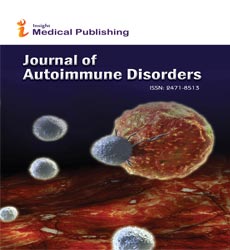Nanomedicine in the Diagnosis and Treatment of Autoimmune Disorders
Tahreem Sultan
Departments of Internal Medicine and Nanomedicine, California Innovations Corporation, San Diego, CA, USA
Published Date: 2025-02-28DOI10.21767/2471-8513.11.1.114
Corresponding author:
Tahreem Sultan,
Departments of Internal Medicine and Nanomedicine, California Innovations Corporation, San Diego, CA, USA,
E-mail: tahreem.s@cic.usa
Received date: February 01, 2025, Manuscript No. ipado-25-20467; Editor assigned date: February 03, 2025, PreQC No. ipado-25-20467 (PQ); Reviewed date: February 15, 2025, QC No. ipado-25-20467; Revised date: February 22, 2025, Manuscript No. ipado-25-20467(R); Published date: February 28, 2025, DOI: 10.21767/2471-8513.11.1.114
Citation: Sultan T (2025) Nanomedicine in the Diagnosis and Treatment of Autoimmune Disorders. J Autoimmune Disord Vol.11.No.1: 114.
Introduction
Autoimmune disorders affect millions worldwide, arising from the immune systemâ??s failure to recognize self from non-self. Conditions such as systemic lupus erythematosus (SLE), rheumatoid arthritis (RA), multiple sclerosis (MS), and type 1 diabetes (T1D) involve chronic inflammation, tissue damage, and loss of organ function. Current treatments, including corticosteroids, immunosuppressants, and biologics, often provide symptomatic relief but are limited by systemic side effects, reduced specificity, and variable efficacy. In recent years, nanomedicine has emerged as a transformative approach in biomedicine, offering innovative solutions for both the diagnosis and treatment of autoimmune diseases. Through nanoscale engineering, researchers are developing tools to deliver drugs more precisely, enhance imaging sensitivity, and restore immune tolerance with minimal toxicity [1,2].
Description
Nanomedicine provides significant advantages in the diagnosis of autoimmune disorders. Nanoparticles such as quantum dots, gold nanoparticles, and magnetic nanomaterials can be engineered to detect disease-specific biomarkers at very low concentrations. For instance, nanoparticle-based biosensors enable early detection of autoantibodies in lupus and rheumatoid arthritis, allowing earlier intervention before irreversible organ damage occurs. Additionally, nanoprobes improve imaging modalities such as MRI and PET scans by enhancing contrast, making it possible to visualize inflammatory lesions in conditions like multiple sclerosis with higher accuracy. These diagnostic advances hold the potential to revolutionize disease monitoring by providing real-time, non-invasive, and highly sensitive tools [3].
In terms of therapy, nanoparticle-based drug delivery systems address major limitations of conventional treatments. Liposomes, polymeric nanoparticles, and dendrimers can encapsulate immunosuppressive drugs or biologics, protecting them from degradation while ensuring targeted delivery to inflamed tissues or specific immune cells. For example, liposomal formulations of corticosteroids have shown improved efficacy in reducing inflammation in rheumatoid arthritis with fewer systemic side effects. Moreover, nanomedicine allows for precision immunomodulation: nanoparticles can deliver tolerogenic antigens directly to dendritic cells, promoting immune tolerance rather than broad immunosuppression. This approach is particularly promising for diseases like type 1 diabetes and multiple sclerosis, where restoring immune balance is key to halting disease progression. [4].
Emerging research also highlights the use of nanovaccines and gene-editing nanoparticles in autoimmune disease therapy. Nanoparticles can be designed to deliver siRNA, CRISPR/Cas components, or microRNAs to immune cells, selectively silencing pro-inflammatory pathways or correcting defective genes. Similarly, nanovaccines that retrain the immune system to tolerate self-antigens are being explored in preclinical studies, offering a paradigm shift from symptomatic treatment to disease modification. Despite these advances, challenges remain, including long-term safety, large-scale manufacturing, and regulatory approval. Nonetheless, the rapid progress of nanomedicine continues to bring new hope for patients with autoimmune disorders [4,5].
Conclusion
Nanomedicine represents a promising frontier in the diagnosis and treatment of autoimmune diseases, offering enhanced precision, specificity, and safety compared to conventional approaches. By enabling early detection through advanced biosensors and imaging tools, and by providing targeted delivery of therapeutics that restore immune tolerance, nanotechnology has the potential to transform patient care. While further research is needed to overcome safety and translational hurdles, ongoing innovations in nanomedicine hold the promise of more effective and personalized management strategies for autoimmune disorders. As the field advances, nanomedicine may shift the paradigm from generalized immunosuppression to precision immunotherapy, ultimately improving outcomes and quality of life for patients.
Acknowledgment
None.
Conflict of Interest
None.
References
- Vargas-Barona A, Bernáldez-Sarabia J, Castro-Ceseña AB (2024). Lipid–polymer hybrid nanoparticles loaded with N-acetylcysteine for the modulation of neuroinflammatory biomarkers in human iPSC-derived PSEN2 (N141I) astrocytes as a model of Alzheimer's disease. J Mater Chem B 12: 5085-5097.
Google Scholar Cross Ref Indexed at
- Dehqan Niri A, Karimi Zarchi AA, Ghadiri Harati P, Salimi A, Mujokoro B (2019). Tissue engineering scaffolds in the treatment of brain disorders in geriatric patients. Artif Organs 43: 947-960.
Google Scholar Cross Ref Indexed at
- Martinez B, Peplow PV (2022). Biomaterial and tissue-engineering strategies for the treatment of brain neurodegeneration. Neural Regen 17: 2108-2116.
Google Scholar Cross Ref Indexed at
- Villanueva-Flores F, Garcia-Atutxa I, Santos A, Armendariz-Borunda J (2023). Toward a new generation of bio-scaffolds for neural tissue engineering: Challenges and perspectives. Pharmaceutics, 15(6), 1750.
Google Scholar Cross Ref Indexed at
- Zhao N, Chung TD, Guo Z, Jamieson JJ, Liang L, et al. (2023). The influence of physiological and pathological perturbations on blood-brain barrier function. Front Neurosci 17: 1289894.
Open Access Journals
- Aquaculture & Veterinary Science
- Chemistry & Chemical Sciences
- Clinical Sciences
- Engineering
- General Science
- Genetics & Molecular Biology
- Health Care & Nursing
- Immunology & Microbiology
- Materials Science
- Mathematics & Physics
- Medical Sciences
- Neurology & Psychiatry
- Oncology & Cancer Science
- Pharmaceutical Sciences
